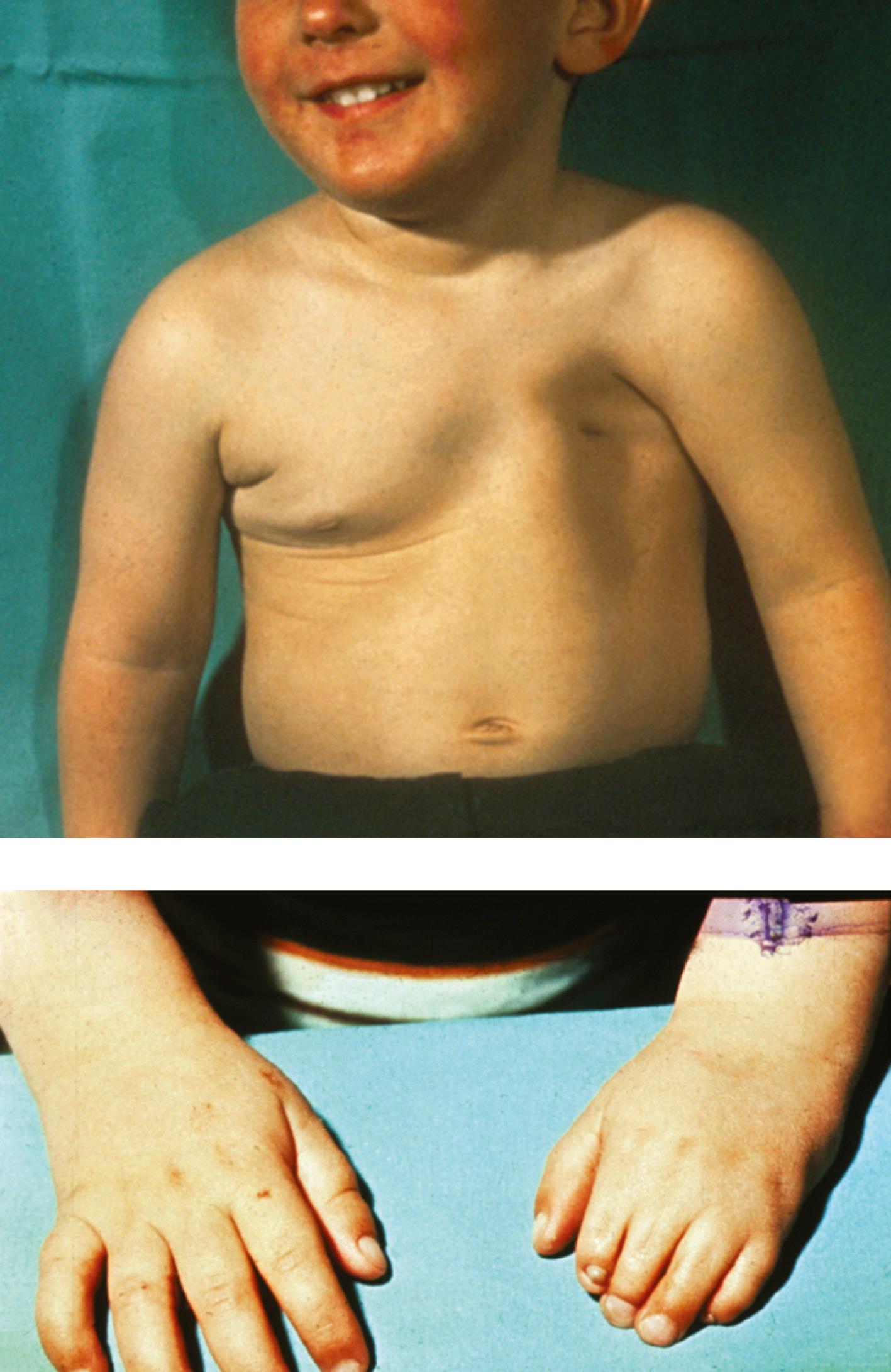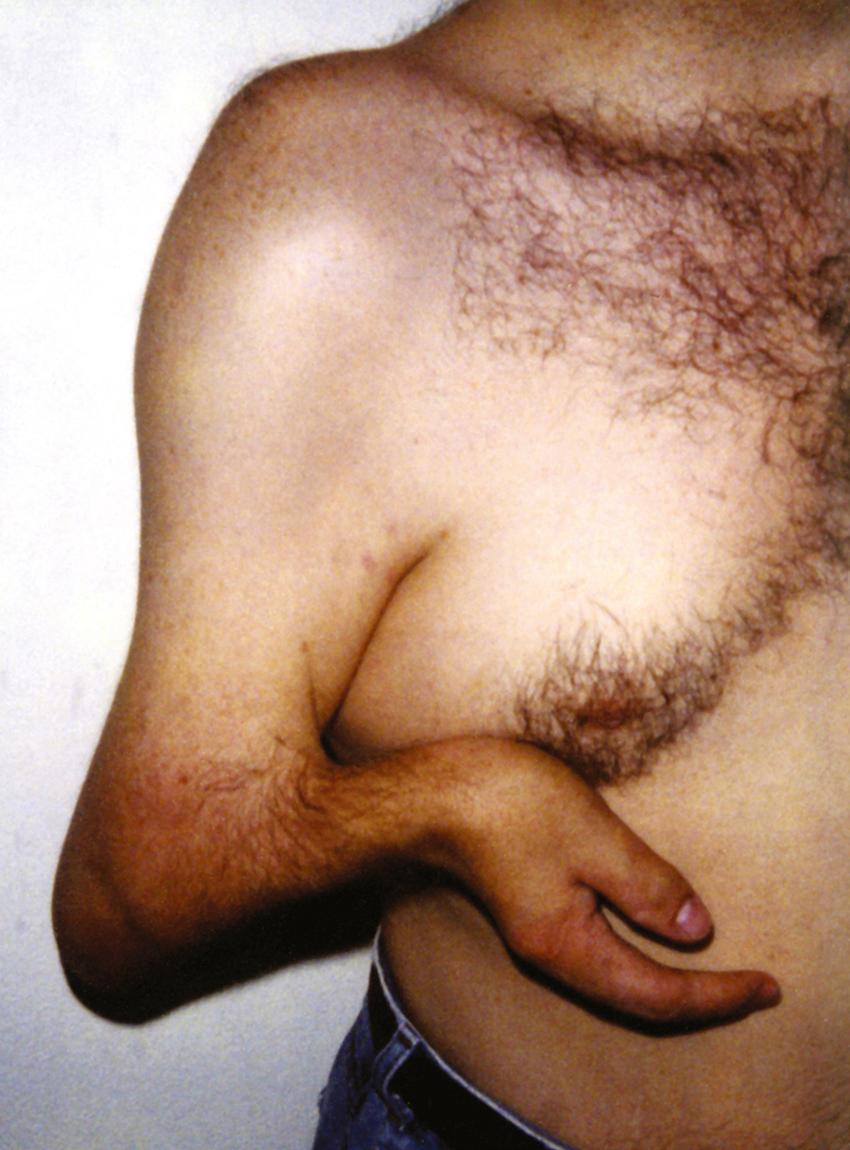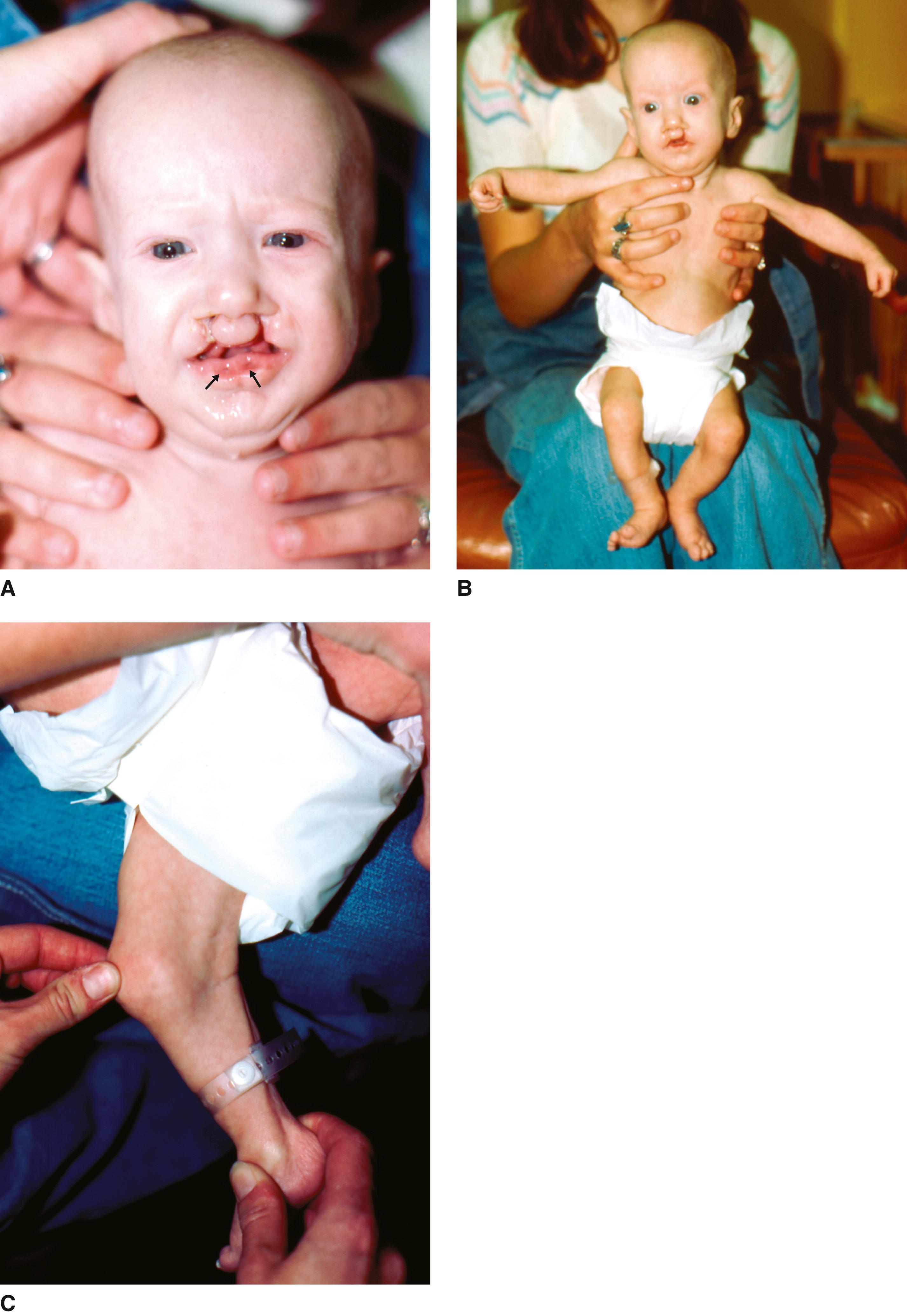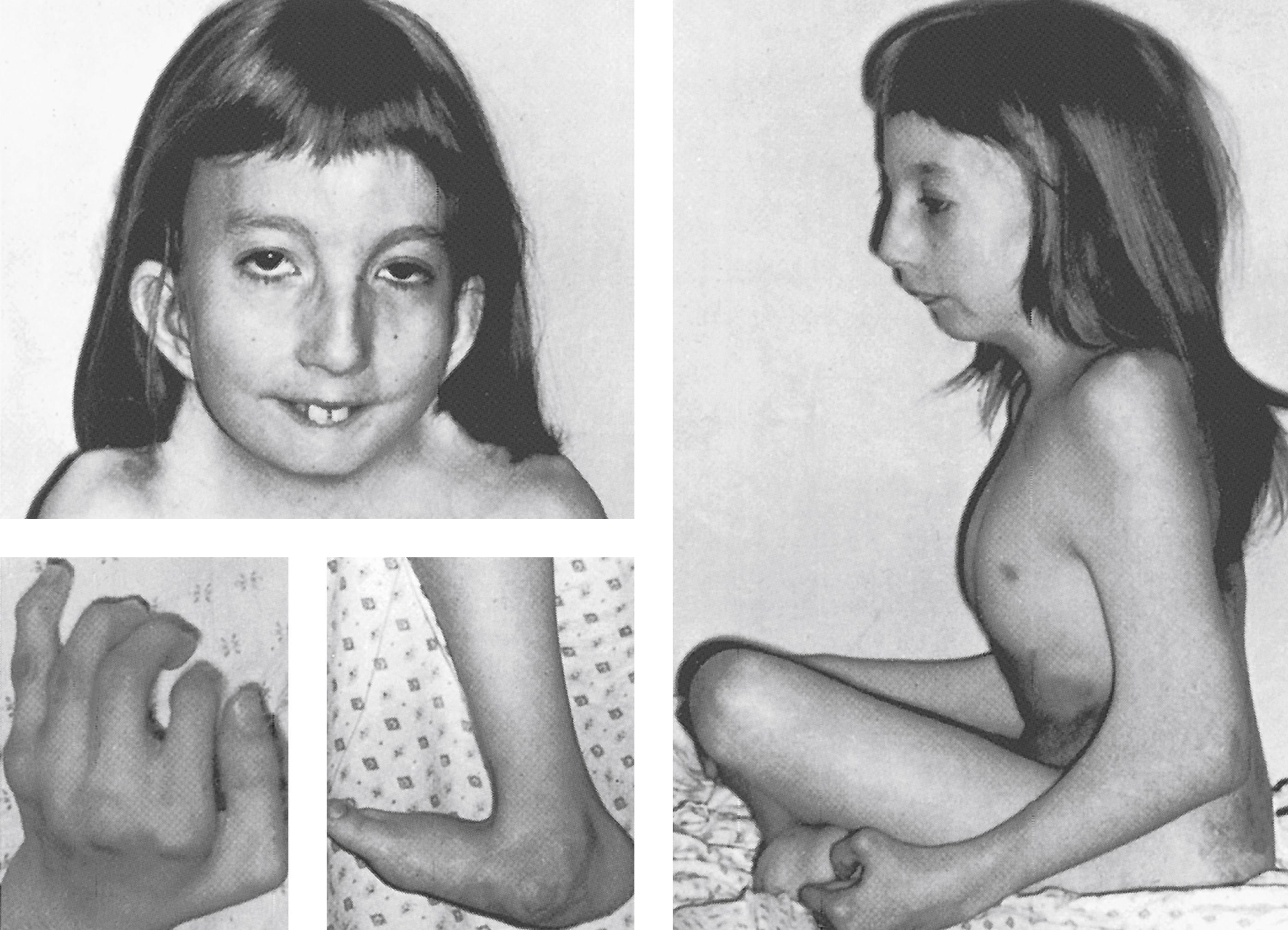Physical Address
304 North Cardinal St.
Dorchester Center, MA 02124
In 1841, Poland reported unilateral absence of the pectoralis minor and the sternal portion of the pectoralis major muscles in an individual who also had cutaneous syndactyly of the hand on the same side. This unique pattern of defects has been noted subsequently in numerous cases and has an incidence of approximately 1 in 20,000. It has been estimated that 10% of patients with syndactyly of the hand have the Poland sequence.
Variable unilateral features from among the following:
Thorax. Hypoplasia to absence of the pectoralis major muscle, nipple, and areola; rib defects, pectus excavatum, pectus carinatum, absent axillary hair, decreased subcutaneous fat.
Upper Limbs. Hypoplasia distally with varying degrees of syndactyly, brachydactyly, oligodactyly, and occasionally more severe reduction deficiency.
Other. Occasional hemivertebrae, renal anomaly, Sprengel anomaly, Klippel-Feil sequence, Moebius sequence, isolated dextrocardia without other cardiovascular defects associated with two or more ipsilateral rib defects in left-sided Poland sequence.
Generally an otherwise normal individual.
The cause of this disorder is unknown. It is three times as common in the male as in the female and is 75% right-sided. Bouvet and colleagues presented evidence of diminished blood flow to the affected side and suggested that the primary defect may be in the development of the proximal subclavian artery, with early deficit of blood flow to the distal limb and the pectoral region, yielding partial loss of tissue in those regions. Bavinck and Weaver have proposed that early interruption of blood flow in the subclavian artery occurs proximal to the origin of the internal thoracic artery, but distal to the origin of the vertebral artery. Credence for a vascular pathogenesis comes from the suggestion that maternal smoking may increase the risk by approximately twofold.
Although the vast majority of cases are sporadic, the incidence of familial transmission has been as high as 4.2% in one large series. Both parent-to-child transmission and affected siblings born to unaffected parents have been reported. In those familial cases both maternal transmission and male gender have raised the question of X-linked genes. However, male-to-male transmission has been reported. In addition, marked variability in expression has been documented, including a number of sibships in which the propositus had the “full” Poland sequence, whereas a sibling or parent had some features of Poland sequence, but lacked hypoplasia or absence of the pectoralis major muscle.
Bavinck and Weaver suggested that the Poland, Klippel-Feil, and Moebius sequences, all of which may occur in various combinations in the same individual, should be grouped together based on a similar developmental pathogenesis into a single category referred to as the “subclavian artery disruption sequence.” They hypothesized that these conditions are the result of diminished blood flow in the subclavian artery, vertebral artery, or their branches during or around the sixth week of development. The pattern of defects depends on the specific area of diminished blood flow.

Originally described in 1882 by Gilly in a woman with mammary hypoplasia, inability to lactate, and absence of the third, fourth, and fifth fingers and ulna, this disorder has been reported in more than 80 patients, both male and female. The clinical phenotype and the molecular characterization have been most extensively delineated by Bamshad and colleagues. The features may be bilateral, but are often asymmetric.
Facies. Broad nasal tip; underdeveloped alae nasi; full cheeks with wide midface; downturned corners of mouth; pointed, prominent chin.
Limb. Hypoplasia of phalanges of fifth digits, partial or complete fifth-digit phalangeal fusion with absent interphalangeal creases, postaxial polydactyly, absence of digits 3 to 5, partial ventral duplication of fifth fingernail, aplasia/hypoplasia of ulna, short radius, absent/hypoplasia of metacarpals 3 to 5.
Apocrine. Diminished/absent axillary hair and perspiration, lack of body odor.
Mammary. Hypopigmentation and hypoplasia of areola, nipple, and breast; normal to absent lactation.
Other. Delayed puberty and skeletal maturation, particularly in males; genital anomalies, including shawl scrotum, micropenis, and cryptorchidism.
Intellectual disability, anophthalmia, absent or ectopic canine teeth, cleft palate, bifid uvula, lingual frenulum extending to tip of tongue, subglottic stenosis, laryngeal web, upslanting palpebral fissures, wide nasal base, imperforate hymen, bicornuate uterus, complete absence of forearm and hand, patent ductus arteriosus, mitral valve prolapse, ventricular septal defect with pulmonic stenosis, cardiac conduction defect, accessory nipples, inverted nipple, carpal bone absence or fusion on ulnar side, hypoplastic flexion creases of first and second digits, short terminal phalanges of toes 4 and 5, hypoplastic humerus, hypoplastic scapula, hypoplastic clavicle, absent/short xiphisternum, obesity, inguinal hernia, renal agenesis, pyloric stenosis, anal atresia/stenosis, anatomic abnormality of pituitary, gonadotropin deficiency, growth hormone deficiency.
Significant delay in growth and skeletal maturation. Puberty and catch-up growth occur, but frequently affected individuals are 5 to 7 years delayed. Testing for growth hormone deficiency as well as screening for cardiac arrhythmias should be offered.
This disorder has an autosomal dominant inheritance pattern. Mutations in TBX3, a member of the T-box gene family that has been mapped to 12q23-24.1, are responsible. A submicroscopic deletion encompassing the TBX3 gene has been documented in at least one affected individual.

This disorder was first reported by Trelat in 1869. More than 80 cases now have been recorded.
Oral. Cleft palate with or without cleft lip (90%), salivary lower lip pits (46%), intraoral fibrous band connecting maxillary and mandibular alveolar ridges (43%), thin upper lip.
Limbs. Popliteal web, in extreme form from heel to ischium (90%). Toenail dysplasia, pyramidal skinfold extending from base to tip of great toe (33%), syndactyly of toes.
Genitalia. Anomalies (51%), including hypoplastic labia majora, scrotal dysplasia, cryptorchidism.
Unusual oral frenula, hypodontia, cutaneous webs between eyelids (20%), atresia of external ear canal, intercrural pterygium (9%), syndactyly of fingers (most commonly digits 3 to 4), bifid toenail, hypoplasia or aplasia of digits, reduction defect of thumb, fusion of distal interphalangeal joints, valgus deformity of feet, talipes equinovarus, hypoplasia of tibia, bifid or absent patella, posterior dislocation of fibulae, low acetabular angle, spina bifida occulta, other vertebral anomalies, bifid ribs, short sternum, scoliosis, renal agenesis, ambiguous external genitalia, penile ectopia or torsion, ectopic testes, underdevelopment of vagina or uterus, inguinal hernia, abnormal scalp hair.
There is usually a dense fibrous cord in the posterior portion of the popliteal pterygium. Magnetic resonance imaging has been used successfully to locate the peroneal nerve and popliteal artery, which often run through the fibrous band, prior to surgical repair. There may be associated defects of muscle in the lower extremities, with limitation of function despite repair of the pterygium. The genital anomalies are most likely owing to distortion by intercrural webs that often run from medial thigh to the base of the phallus. Other webbing across the eyelids or in the mouth may require excision. Although a number of cosmetic and orthopedic corrective procedures are required frequently, normal intelligence and good ambulation should be anticipated in most affected individuals.
An autosomal dominant inheritance pattern is implied, with wide variability in severity. Mutations in the gene encoding interferon regulatory factor 6 (IRF6), located at chromosome 1q32-q41, are responsible for 97% of cases of this disorder. In addition, one case has been described of an IRF6 recessive mutation causing Popliteal pterygium syndrome. However the majority of cases of recessive popliteal pterygium syndrome, also known as Bartsocas-Papas syndrome, are caused by mutations of RIPK4 (receptor-interacting serine/threonine kinase protein 4). Cases with Bartsocas-Papas syndrome are generally more severe than those of autosomal dominant popliteal pterygium syndrome. However, there have been a number of cases in which RIPK4 mutations have led to a wide range of severity from mild to more severe. Autosomal dominant mutations of IRF6 are also responsible for 68% of cases of Van der Woude syndrome, indicating that these two disorders are allelic.

Originally described by Bussière in 1902, this disorder was fully delineated by Escobar and colleagues in 1978.
Growth. Small stature.
Facies. Ptosis of eyelids with downslant of palpebral fissures; inner canthal folds; hypertelorism; micrognathia with downturning corners of mouth; difficulty opening mouth widely; long philtrum; cleft palate; sad, flat, emotionless face; low-set ears.
Pterygia. Pterygia of neck, axillae, antecubital, popliteal, and intercrural areas.
Limbs. Pterygia plus camptodactyly, syndactyly, equinovarus, or rocker-bottom feet.
Genitalia. Cryptorchidism, absence of labia majora.
Other. Scoliosis, kyphosis, fusion of vertebrae or fused laminae, rib anomalies, absent or dysplastic patella.
Intrauterine growth restriction; anterior clefts of vertebral bodies, tall vertebral bodies with decreased anteroposterior diameter, failed fusion of posterior neural arches; rib fusion; long clavicles with lateral hooks; modeled scapulae; dislocated radial head; distal radioulnar separation; vertical talus; muscle atrophy; dislocation of hip; hypoplastic and/or widely spaced nipples; conductive hearing loss; abnormal ossicles; diaphragmatic eventration; hypospadias; cardiac defects.
There is an increased frequency of abortions and stillbirths. Most affected individuals become ambulatory. Intelligence is normal. Respiratory problems, including pneumonia, plus episodes of dyspnea and apnea presumably secondary to the kyphoscoliosis and small chest size lead to significant morbidity as well as death in the first year of life in approximately 6% of patients.
Clinical features frequently develop past infancy in the first few years of life. For example, pterygia may become more obvious with time, leading to fixed contractures. Early, vigorous physical therapy is indicated to retain the greatest joint mobility. On the other hand, other features such as camptodactyly often improve with age. Scoliosis occurs before 5 years of age in the majority of patients and frequently requires surgical fusion. Formal hearing evaluation is indicated in all individuals.
This disorder has an autosomal recessive inheritance pattern. Mutations in the γ-subunit gene ( CHRNG ) of the acetylcholine receptor (AChR) are responsible for 27% of cases. These mutations lead to fetal akinesia with arthrogryposis and multiple pterygia. However, the γ-subunit is not a constituent part of the adult acetylcholine receptor, which takes over from the embryonal acetylcholine receptor in the third trimester. Therefore, postnatal muscle weakness and fatigue are not seen in patients with Escobar syndrome who are CHRNG positive. However diaphragmatic muscle weakness, diffuse myopathy and myasthenic-like feature are often reported.
A rare autosomal dominant multiple pterygium syndrome referred to as “distal arthrogryoposis type 8,” caused by mutations in MYH3 (myosin heavy chain) have been reported. The principal features include pterygia, camptodactyly of hands, vertebral fusion defects, and scoliosis. (see page 240)
Mutations in CHRNG have also been seen in the lethal multiple pterygium syndrome (page 240). Although the lethal multiple pterygium syndrome and the Escobar syndrome phenotypes are seen in different families with the same CHRNG mutation, estimate is that a 95% chance exists that subsequent siblings in the same family will have the same phenotype as the proband.

Falek and colleagues reported two female siblings with this unique pattern of malformation in 1968, and Shear noted a comparable case. The term CHILD is an acronym for c ongenital h emidysplasia with i chthyosiform erythroderma, and l imb d efects.
Growth. Mild prenatal growth deficiency.
Limbs. Unilateral hypomelia varying from absence of a limb to hypoplasia of some metacarpals and phalanges, webbing at elbows and knees, joint contractures.
Skin. Unilateral ichthyosiform skin lesion, sometimes referred to as an “ichthyosiform nevus” or “inflammatory epidermal nevus,” with midline demarcation; small patches of involved skin may occur on the opposite side; unilateral alopecia, hyperkeratosis, and nail destruction; histologically, there is a thick parakeratotic stratum corneum overlying a psoriasiform, acanthotic epidermis, often with inflammatory infiltration and lipid-laden histiocytes.
Other Skeletal. Ipsilateral hypoplasia of bones involving any part of the skeleton, including mandible, clavicle, scapula, ribs, and vertebrae; ipsilateral punctate epiphyseal calcifications during infancy.
Other. Cardiac septal defects, single coronary ostium, single ventricle, unilateral renal agenesis.
Ipsilateral hypoplasia of brain, cranial nerves, spinal cord, lung, thyroid, adrenal gland, ovary, and fallopian tube; mild intellectual disability; mild contralateral anomalies of skin, bone, or viscera; scoliosis; cleft lip; umbilical hernia; hearing loss; meningomyelocele.
Become a Clinical Tree membership for Full access and enjoy Unlimited articles
If you are a member. Log in here